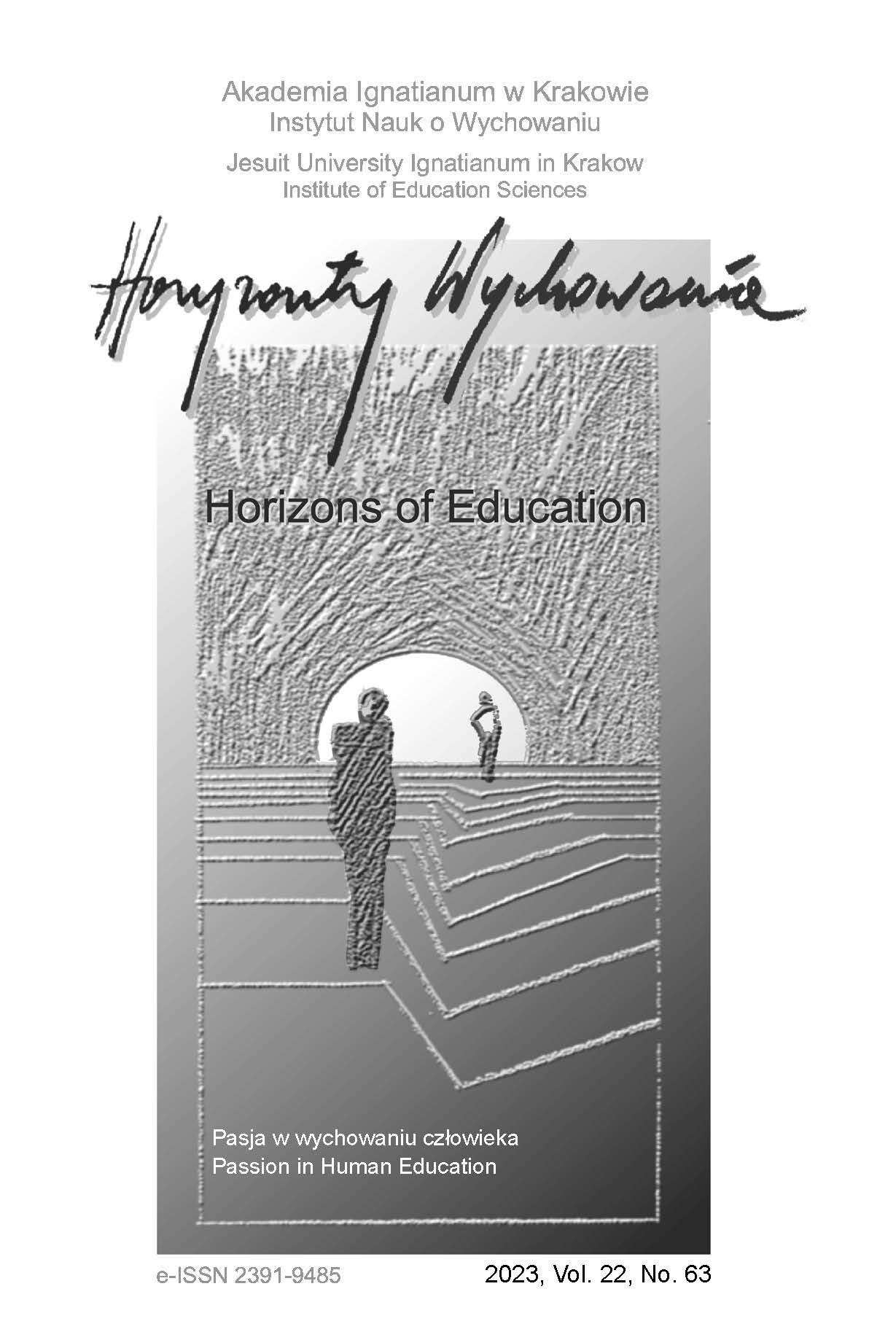The Relationship Between the Harmonious Passion Development and the Human Integral Development: Educational Perspective in Brief
Abstrakt
CEL NAUKOWY: Celem naukowym artykułu jest poznanie związku pomiędzy integralnym rozwojem człowieka z rozwojem harmonijnej pasji (HP).
PROBLEM I METODY BADAWCZE: Problem badawczy prowadzonych badań zawiera się w pytaniu: Jakie przedstawia się związek pasji w wymiarze harmonijnym z integralnym rozwojem podmiotu edukacyjnego? Udzielenie odpowiedzi na postawione pytanie umożliwia zastosowanie metody hermeneutycznej eksplorującej znaczenie tegoż związku fenomenologicznego.
PROCES WYWODU: Proces badawczy ma charakter teoriopoznawczy. Odnosi się do dualistycznego modelu pasji, zwłaszcza harmonijnej pasji, integralnego rozwoju człowieka. Dostrzeżenie korelacji pomiędzy powyższymi aspektami może być nie lada wyzwaniem dla nauczycieli i uczniów z ich postawą pełną pasji dla odkrywania i formowania własnej tożsamości.
WYNIKI ANALIZY NAUKOWEJ: Analiza zgromadzonego materiału wskazała na znaczenie rozwoju harmonijnej pasji dla integralnego rozwoju podmiotów edukacyjnych w przestrzeni życia biologicznego, psychologicznego, społecznego, kulturowego i duchowego oraz kształtowania się autonomicznej tożsamości.
WNIOSKI, INNOWACJE, REKOMENDACJE: Badania teoretyczne w powyższym obszarze mogą zwrócić uwagę pedagogów na znaczenie harmonijnej pasji postrzeganej wielowymiarowo, odzwierciedlanej w działalności edukacyjnej, co wymaga rewizji i aktualizacji programów edukacyjnych, stymulujących wydobywanie potencjału twórczego podmiotów edukacyjnych. Może to służyć głębszemu poznawaniu siebie, innych i świata na drodze autonomicznego stawania się Self.
Bibliografia
Chen, P., Lin, Y., Pereira, D.J.H., O’Keefe, P.A., & Yates, J.F. (2021). Fanning the flames of passion: Adevelop mindset predicts strategy-use intentions to cultivate passion. Frontiers in Psychology, 12, Article 634903. https://www.frontiersin.org/articles/10.3389/fpsyg.2021.634903/full
Chichekian, T., & Vallerand, R.J. (2021). Passion for science and the pursuit of scientific studies: The mediating role of rigid and flexible persistence and activity involvement. Learning and Individual Differences, 93, Article 102104. https://doi.org/10.1016/j.lindif.2021.102104
Crocett, E., Albarello, F., Meeus, W., & Rubini, M. (2023). Identities: A developmental social-psychological perspective. European Review of Social Psychology, 34(1), 161–201. https://doi.org/10.1080/10463283.2022.2104987
De Bono, E. (1985). Six thinking hats. Penguin Books.
Forest, J., Mageau, G.A., Crevier-Braud, L., Bergeron, É., Dubreuil, Ph., & Lavigne, G.L. (2012). Harmonious passion as an explanation of the relation between signature strengths’ use and well-being at work: Test of an intervention program. Human Relations, 65(9), 1233–1252, https://doi.org/10.1177/0018726711433134
Fuster-Guillén, D. (2019). Qualitative research: Hermeneutical phenomenological method. Propósitos y Representaciones, 7(1), 201–229. http://dx.doi.org/10.20511/pyr2019.v7n1.267
Głowala, A., Kołodziejski, M., & Butvilas, T. (2023). Reflection as a basic category of a teacher’s thinking and action. Multidisciplinary Journal of School Education, 12(1), 229–250. https://doi.org/10.35765/mjse.2023.1223.10
Hidi, S., & Renninger, K.A. (2006). The four-phase model of interest development. Educational Psychologist, 41(2), 111–127. https://doi.org/10.1207/s15326985ep4102_4
Koczanowicz-Dehnel, I. (2011). Hermeneutyka a narracja. Teraźniejszość – Człowiek – Edukacja, 3(55), pp. 23–35.
Kunowski, S. (2000). Podstawy współczesnej pedagogiki. Wydawnictwo Salezjańskie.
Nęcka, E. (2003). Psychologia twórczości. Gdańskie Wydawnictwo Psychologiczne.
Paquette, V., Holding, A., Cimon-Paquet, C., Giroux, A., Boucher, V.G., & Vallerand, R.J. (2023). Pursuing, developing, and letting go of a passionate activity when facing adversity during a pandemic: Associations with well-being and ill-being. Personality and Individual Differences, 209, Article 112217. https://doi.org/10.1016/j.paid.2023.112217
Perttula, K.H., & Cardon, M.S. (2011). Passion. In K.S. Cameron & G.M. Spreitzer (Eds.), The Oxford Handbooks Online of positive organizational scholarship (pp. 190–200). Oxford University Press.
Peterson, C., Park, N., & Seligman, M.E. (2005). Orientations to happiness and life satisfaction: The full life vs. the empty life. Journal of Happiness Studies: An Interdisciplinary Forum on Subjective Well-Being, 6(1), 25–41. https://doi.org/10.1007/s10902-004-1278-z
Sheldon, K.M. (2002) The self-concordance model of healthy goal-striving: When personal goals correctly represent the person. In E.L. Deci, & R.M. Ryan (Eds.), Handbook of self-determination research (pp. 65–86). University of Rochester Press.
Szymańska, M. (2017). Transformative creativity in teacher formation: A pedagogical approach. Akademia Ignatianum w Krakowie, Wydawnictwo WAM.
Szymańska, M. (2018). Reflection in the integral development of a teacher: A pedagogical perspective. Hungarian Educational Research Journal, 8(3), 62–72. https://www.academia.edu/43157684/HERJ_Volume_8_Issue_3
Szymańska, M. (2019). Portfolio w kształceniu nauczycieli. Wydawnictwo Naukowe Akademii Ignatianum.
Vallerand, R.J. (2008). On the psychology of passion. In search of what makes people’s lives most worth living. Canadian Psychology/Psychologie Canadienne, 49(1), 1–13. https://doi.org/10.1037/0708-5591.49.1.1
Vallerand, R.J. (2015). The psychology of passion: A dualistic model. Oxford University Press. https://doi.org/10.1093/acprof:oso/9780199777600.001.0001
Vallerand, R.J. (2017). On the two faces of passion: The harmonious and the obsessive. In P. O’Keefe & J. Harackiewicz (Eds.), The science of interest (pp. 149–173). Springer. https://doi.org/10.1007/978-3-319-55509-6_8
Vallerand, R.J. (2020). Passion in education: Theory, research, and applications. In G. Liem & D. McInerney (Eds.), Educational interventions: A sociocultural perspective (pp. 115–147). Information Age Publishing.
Vallerand, R.J., & Houlfort, N. (2003). Passion at work: Toward a new conceptualization. In S.W. Gilliland, D.D. Steiner, & D.P. Skarlicki (Eds.), Emerging perspectives on values in organizations (pp. 175–204). Information Age Publishing
Vallerand, R.J., & Houlfort, N. (Eds.). (2019). Passion for work: Theory, research, and applications. Oxford University Press. https://doi.org/10.1093/oso/9780190648626.001.0001
Vallerand, R.J., Paquet, Y., Philippe, F.L., & Charest, J. (2010). On the role of passion for work in burnout: A process model. Journal of Personality, 78(1), 289–312. https://doi.org/10.1111/j.1467-6494.2009.00616.x
Witkowski, L. (1988). Tożsamość i zmiana. Wstęp do epistemologicznej analizy kontekstów edukacyjnych. Wydawnictwo UMK.
Zhou, J. (2021). How does dualistic passion fuel academic thriving? A joint moderated–mediating model. Frontiers in Psychology, 12, Article 666830. https://doi.org/10.3389/fpsyg.2021.666830
Copyright (c) 2023 Horyzonty Wychowania

Utwór dostępny jest na licencji Creative Commons Uznanie autorstwa – Bez utworów zależnych 4.0 Międzynarodowe.
Uwagi dotyczące praw autorskich
Autorzy publikujący w tym czasopiśmie wyrażają zgodę na następując warunki:
- Autorzy zachowują prawa autorskie, przyznając czasopismu prawo do pierwszej publikacji swojego tekstu jednocześnie zarejestrowanego pod numerem licencji CC BY-ND, która pozwala innym na korzystanie z tego tekstu z uznaniem autorstwa tekstu oraz pierwotnej publikacji w tym czasopiśmie.
- Autorzy proszeni są o nawiązywanie odrębnych, dodatkowych porozumień wynikających z umowy, dotyczących dystrybucji opublikowanej w czasopiśmie wersji tekstu nie na prawach wyłączności (np. opublikowanie go w repozytorium instytucji lub w innym czasopiśmie), z potwierdzeniem pierwszej publikacji w tym czasopiśmie.
Wyraża się zgodę i zachęca autorów do publikacji ich tekstu w Internecie (np. w repozytorium instytucji lub na jej stronie internetowej) przed lub podczas procesu składania tekstu jako, że może to prowadzić do korzystnych wymian oraz wcześniejszego i większego cytowania opublikowanego tekstu (Patrz The Effect of Open Access). Zalecamy wykorzystanie dowolnego portalu stowarzyszeń badawczych z niżej wymienionych:





